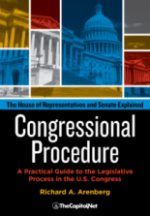Party leadership is responsible for bringing efficiency and order to the legislative body. Party leaders have partisan and institutional functions. The responsibility of the majority leadership is to set the agenda as well as determine legislative priorities and political strategies, assess support for legislation, schedule measures for floor action and round up votes for the passage of legislation. The minority leadership is responsible for devising strategies for the purpose of upsetting the majority’s plans.

The position of Speaker of the House is provided for in Article I, Section 2 of the Constitution. This is the most senior officer of the House and also the third most senior official in the federal government. The Speaker presides over the House and also refers measures to committees. Other responsibilities include making rulings on points of order and setting the agenda. Additionally, the Speaker has priority for recognition on the floor. This position is elected by a majority vote of the House. Candidates may be nominated by their respective party caucus.

Congressional Leadership and Committees
The second most senior official in the House is the majority leader. This is the person who is responsible for the day to day management of business on the floor. The majority leader is elected by the majority party caucus and is responsible for building and managing their party’s consensus on legislation.
The job of the majority whip is to persuade members to support the position of his or her party. The majority whip is responsible for measuring and rounding up support for party positions. There are also numerous assistant whips that work with the majority whip. This network of assistant whips can include chief deputy whips, regional whips and even class whips. The majority whip is elected by the majority party caucus.
Congressional Leadership: Crash Course Government and Politics #8
The minority leader is the senior official for the minority party and is responsible for working within the party to set a message, agenda and strategy. They may also appoint minority party members to commissions and task forces. The minority leader is elected by the minority party caucus.
The minority whip is responsible for persuading members to support their party’s position. They also count votes. A network of assistant whips also work with the minority whip.
To learn more, see CongressLeaders.com for a listing of the current congressional leadership.
More
- Congressional Leadership and Committees
- Majority Leader (CongressionalGlossary.com)
- Speaker (CongressionalGlossary.com)
- Ranking Minority Member / Ranking Member (CongressionalGlossary.com)
- Whip, Majority Whip, Minority Whip (CongressionalGlossary.com)
- Caucus / Congressional Member Organization / CMO / Congressional Staff Organization / CSO (CongressionalGlossary.com)
- Congressional Procedure
- Congressional Directory
- Congressional Deskbook
- How Our Laws Are Made
- Committee Markup in the U.S. House of Representatives
Courses
- Congressional Operations Briefing – Capitol Hill Workshop
- Drafting Federal Legislation and Amendments
- Writing for Government and Business: Critical Thinking and Writing
- Custom, On-Site Training
- Drafting Effective Federal Legislation and Amendments in a Nutshell, Audio Course on CD
- Congress, the Legislative Process, and the Fundamentals of Lawmaking Series, a Nine-Course series on CD
Publications

Legislative Drafter’s Deskbook: A Practical Guide

Pocket Constitution

Citizen’s Handbook to Influencing Elected Officials: A Guide for Citizen Lobbyists and Grassroots Advocates

Congressional Procedure
CongressionalGlossary.com, from TheCapitol.Net
For more than 40 years, TheCapitol.Net and its predecessor, Congressional Quarterly Executive Conferences, have been teaching professionals from government, military, business, and NGOs about the dynamics and operations of the legislative and executive branches and how to work with them.
Our custom on-site and online training, publications, and audio courses include congressional operations, legislative and budget process, communication and advocacy, media and public relations, testifying before Congress, research skills, legislative drafting, critical thinking and writing, and more.
TheCapitol.Net is on the GSA Schedule, MAS, for custom on-site and online training. GSA Contract GS02F0192X
TheCapitol.Net is now owned by the Sunwater Institute.
Teaching how Washington and Congress work ™

